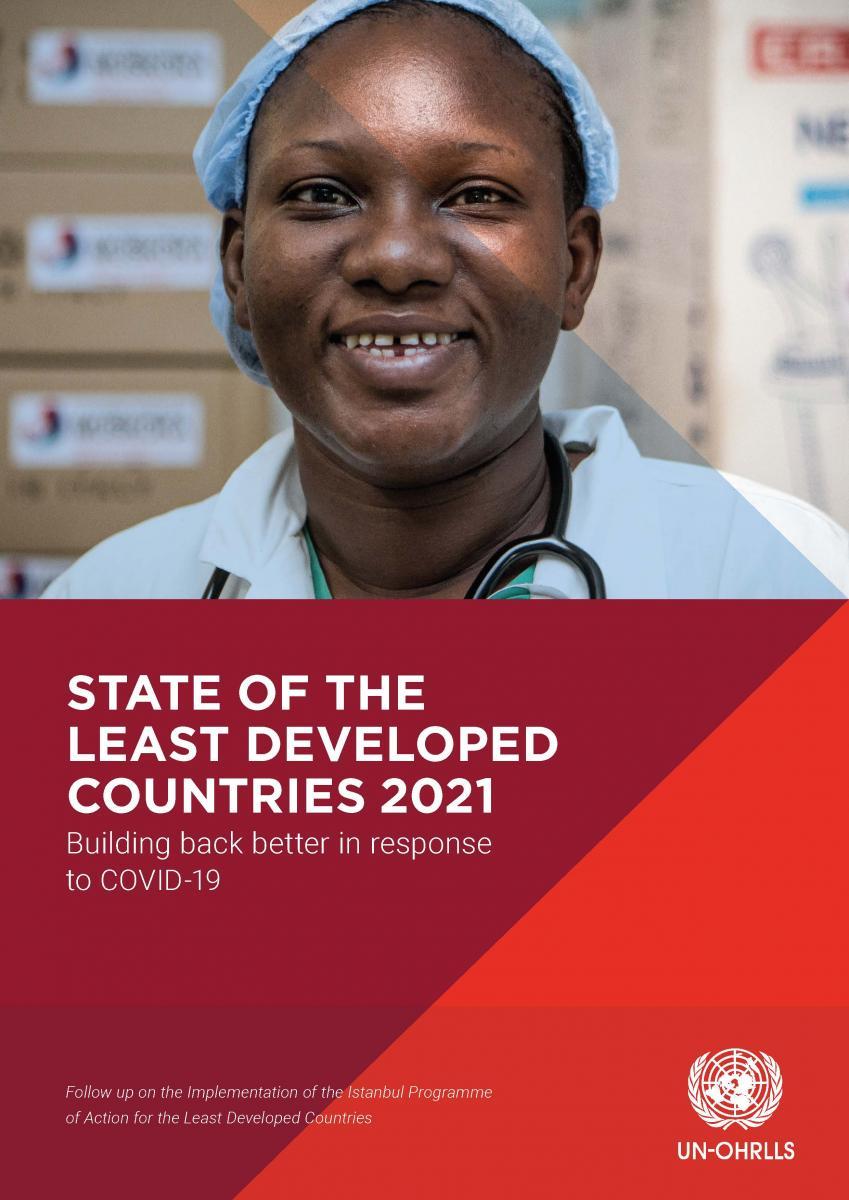State of the Least Developed Countries 2021. Building back better in response to COVID-19

The State of the Least Developed Countries 2021 report is a comprehensive assessment of where the Least Developed Countries (LDCs) stand a year into the COVID-19 pandemic. The report calls for a global coordinated response for LDCs that goes beyond recovery, ensuring that the most vulnerable countries can both get their development back on track and better prepare for future crises.
The report provides recommendations where actions are most needed - from investment in people to sustainable structural transformation and the use of technologies to the mobilization of finance.
These recommendations go well beyond recovery from COVID-19, but their implementation would ensure that LDCs can also enhance resilience to future shocks and accelerate the achievement of their development goals.
COVID-19 in the LDCs
While COVID-19 cases seemed relatively low in LDCs at the beginning of the pandemic, they picked up in several countries towards the end of 2020. Currently, as many countries deal with a spike in cases, many fresh waves are taking place in countries with an already critical political, humanitarian or economic situation.
The rate of extreme poverty in LDCs was about 35.1 per cent in 2018, before the pandemic struck. Early data on the impact of the pandemic on poverty show that figure growing, wiping out years of progress made in alleviating poverty. Due to their over-representation in the labour-intensive, low-skilled activities that were most affected by lockdowns, women were most severely affected.
The report notes that the urgent support needed by LDCs is significant, as the amounts they have been able to spend on damping down the pandemic have been significantly lower. Most LDCs have increased public spending but the size of these fiscal packages were much lower than in other developing countries and the developed world. In fact, LDCs managed to increase direct and indirect fiscal support by only 2.6 per cent of their GDP in 2020, compared to, on average, 15.8 per cent of developed countries’ much larger GDPs.
Response Measures
Central to the COVID-19 response is plugging the gaps that made it difficult for LDCs to mount strong pandemic measures and ensuring that the most marginalised communities are supported with the basic infrastructure to stay engaged in production, education and healthcare.
Rural areas in particular need greater investment in services and financial instruments that target producers’ organisations like credit guarantee funds that can support investment plans and increase productivity.
COVID-19 saw millions of young people unable to access education, and while several LDCs have increased access to remote learning platforms, many more remain without electricity, internet or appropriate devices. These learning inequalities, widened by the pandemic, must also be tackled as a matter of urgency if this is not to become a lost generation.
Similarly, access to clean, affordable energy will be critical to supporting LDCs to grow production. Energy transition investment can help reinvigorate the economy, support the recovery phase, and create a wide range of jobs.
LDC5
The report is published in advance of the Fifth UN Conference on the Least Developed Countries (LDC5). LDC5 is where the international community will take stock of progress and challenges made in LDCs over the past decade and enact an ambitious new ten-year programme to accelerate development. It will be held in two parts: the adoption of the new Doha Programme of Action which occurred at the United Nations on March 17, 2022 and the main conference in Doha on 5-9 March 2023.
Table of contents
A. Spread of COVID-19 and direct health effects
A.1 The State of COVID-19 in Least Developed Countries
A.2 Early effective public health responses, demographics and other factors
A.3 Covid-19 impact on other diseases or medical treatments
A.4 Policy recommendations and progress towards ensuring equitable
distribution of effective vaccines to the LDCs
B. The consequences of COVID-19 on wellbeing
B.1 Impact of COVID-19 on poverty
B.2 Impact of COVID-19 on the Labour Market and Income
B.3 Effect of COVID-19 on access to education and other social services
B.4 Conclusions and recommendations
C. Effects of COVID-19 on food security, nutrition, and agriculture in the LDCs
C.1 An overview of the state of Food insecurity and nutrition in the LDCs
C.2 COVID impact on food security and nutrition
C.3 Strengthened support for smallholder farmers and agriculture
and addressing the challenges of COVID-19
C.4 Access to finance
C.5 Promoting rural infrastructure and the domestic food value chain
C.6 Leveraging science, Technology and Innovation for agriculture
D. Trade and productive capacity were hit hard
D.1 Trade-related impacts
D.2 Impact on Productive Capacity
D.3 Building trade and productive capacity — sustainably
D.4 Conclusion and the way forward
E. Macroeconomic indicators deteriorated in all LDCs
E.1 Decline in GDP
E.2 Price volatility, exchange rates, monetary policies
E.3 Fiscal deficits increasing
E.4 Conclusions and Recommendations
F. The role of science, technology and innovation (STI) during a pandemic: How can STI help to build back better
F.1 STI challenges in LDCs
F.2 The increasing role of STI during COVID-19
F.3 Digital finance
F.4 Conclusions and recommendations
G. Financing to address the COVID-19 crisis and prepare for a sustainable recovery
G.1 FDI experienced sharp declines
G.2 International Migration and Remittances
G.3 Concessional finance under threat
G.4 LDCs need debt relief
G.5 Conclusions and recommendations
H. Resilience package for recovery and preparedness for future shocks
H.1 COVID 19 – a systemic risk
H.2 building back better and enhancing resilience
H.3 Multi-hazard early warning system (MHEWS)
H.4 Multi-hazard crises mitigation and resilience building mechanism for LDCs
H.5 Conclusion and recommendations



